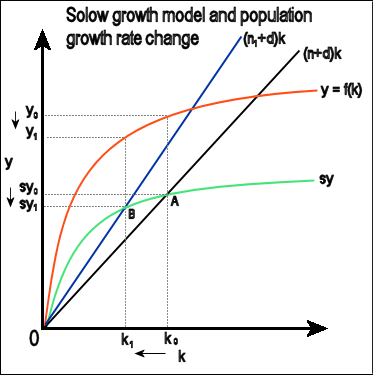Population Growth
Unraveling Population Dynamics: The Ebb and Flow
Population Dynamics:
- Ever-Changing Size: Population size is dynamic, fluctuating with factors like food availability, predation, and weather.
- Indicators of Change: Changes in population density provide insights into its status—whether thriving or declining.
Basic Processes Influencing Population Density:
- Natality (Births): Number of births in a given period contributing to an increase in population density.
- Mortality (Deaths): Number of deaths in the population during a given period leading to a decrease in population density.
- Immigration: Individuals of the same species entering the habitat from elsewhere, contributing to increased density.
- Emigration: Individuals leaving the habitat, leading to a decrease in population density.
Equation of Population Density Change:
- Population Density Formula: Nt+1 = Nt + [(B + I) – (D + E)]
- Interpretation: Density at time t + 1 is determined by the initial density plus the net effect of births, deaths, immigration, and emigration.
Factors Influencing Density Change:
- Dominant Role of Births and Deaths: Under normal conditions, births and deaths primarily shape population density.
- Special Conditions: Factors like immigration and emigration become significant under specific circumstances (e.g., colonization of a new habitat).
Growth Model
Exponential Explosion: The Chessboard Conundrum
Exponential Growth:
- Unlimited Resources: Population growth is idealized when resources are unlimited, allowing species to realize their full growth potential.
- Darwin’s Insight: Darwin observed exponential growth, described by the equation dN/dt = rN, where r is the intrinsic rate of natural increase.
Exponential Growth Equation:
- Mathematical Form: dN/dt=(b–d)×N, where (b – d) is represented by r.
- J-Shaped Curve: Results in a J-shaped curve when plotting population density (N) against time.
Magnitude of r Values:
- Parameter Significance: r is the intrinsic rate of natural increase, a crucial parameter assessing impacts on population growth.
- Examples: r values for species like the Norway rat (0.015) and flour beetle (0.12).
Exponential Growth Equation (Integral Form):
- N0Nt=ert, where:
- Nt: Population density after time t
- 0N0: Population density at time zero
- r: Intrinsic rate of natural increase
- e: Base of natural logarithms (2.71828)
- N0Nt=ert, where:
Anecdote: The Chessboard Bet:
- Minister’s Proposal: The minister proposed a bet based on placing wheat grains on a chessboard—doubling each time to fill all 64 squares.
- King’s Dilemma: The king, confident at first, realized the enormity of exponential growth, unable to fulfill the wheat quantity for all 64 squares.
- Paramecium Analogy: Relating the story to Paramecium, starting with one individual doubling through binary fission, reaching a staggering population in 64 days.
Logistic Labyrinth: Carrying Capacity in Population Growth
Logistic Growth Realism:
- Limited Resources: No species has unlimited resources, leading to competition and the need for a realistic model.
- Competition Outcome: The ‘fittest’ individuals survive, reproduce, and contribute to population growth.
- Human Population Control: Governments implement restraints to control human population growth, acknowledging resource limitations.
Carrying Capacity Concept:
- Maximum Limit: Every habitat has a carrying capacity (K), representing the maximum number a population can sustain.
- Population Dynamics: Habitat with limited resources leads to initial lag, acceleration, deceleration, and eventual asymptote as population density reaches carrying capacity.
Verhulst-Pearl Logistic Growth Equation:
- (1−)dtdN=rN(1−KN)
- N: Population density at time t
- r: Intrinsic rate of natural increase
- K: Carrying capacity
- (1−)dtdN=rN(1−KN)
Sigmoid Curve:
- Phases in Growth:
- Lag Phase: Initial slow growth
- Acceleration: Rapid population increase
- Deceleration: Growth slows down
- Asymptote: Population stabilizes at carrying capacity
- Graphical Representation: Sigmoid curve depicts Verhulst-Pearl Logistic Growth.
- Phases in Growth:
Realistic Model:
- Finite Resources: Most animal populations face finite resources, making the logistic growth model more realistic.
Population Growth in India:
- Census Data Analysis: Examine the population figures for India over the last century.
- Graphical Representation: Plot the data to identify growth patterns.
Life History Evolution: Maximizing Reproductive Fitness
Darwinian Fitness and Reproductive Strategy:
- Objective: Populations aim to maximize reproductive fitness (high �r value) in their habitat.
- Efficient Reproduction: Organisms evolve under specific selection pressures to adopt efficient reproductive strategies.
Life History Variation:
- Reproductive Strategies:
- Single Breeding: Some organisms breed only once in their lifetime (e.g., Pacific salmon fish, bamboo).
- Multiple Breeding: Others breed multiple times during their lifetime (e.g., most birds and mammals).
- Offspring Characteristics:
- Numerous Small Offspring: Some produce a large number of small-sized offspring (e.g., oysters, pelagic fishes).
- Few Large Offspring: Others produce a small number of large-sized offspring (e.g., birds, mammals).
- Reproductive Strategies:
Maximizing Fitness: Ecological Perspective:
- Evolutionary Adaptation: Life history traits evolve based on constraints imposed by the habitat’s abiotic and biotic components.
- Ecological Research: Ongoing research focuses on understanding the evolution of life history traits in different species.


